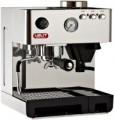Add to comparison |  |  |
|---|---|---|
| Lelit Anita PL042TEMD chrome | Lelit Anita PL042EM stainless steel | |
| Compare prices 2 | from £660.15 | |
| TOP sellers | ||
| Type | espresso (portafilter) | espresso (portafilter) |
| Built-in coffee grinder | + | + |
| Used coffee | in grains ground pods | in grains ground pods |
Programs and adjustments | ||
| Modes | hot water | hot water |
| Milk drinks preparation | manual | manual |
| Adjustments | degree of grinding of coffee beans steam pressure | degree of grinding of coffee beans steam pressure |
Specs | ||
| Cups in one go | 2 pcs | 2 pcs |
| Water tank | 2.7 L | 2.7 L |
| Coffee grinder capacity | 150 g | 150 g |
| Features | cup / coffee pot heating pressure gauge | cup / coffee pot heating pressure gauge |
| Pressure | 9 bar | 15 bar |
General | ||
| Power consumption | 1250 W | 1200 W |
| Dimensions (WxHxD) | 33x25x37 cm | |
| Color | ||
| Added to E-Catalog | october 2016 | may 2015 |